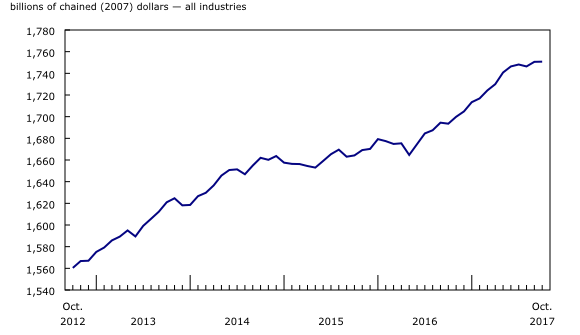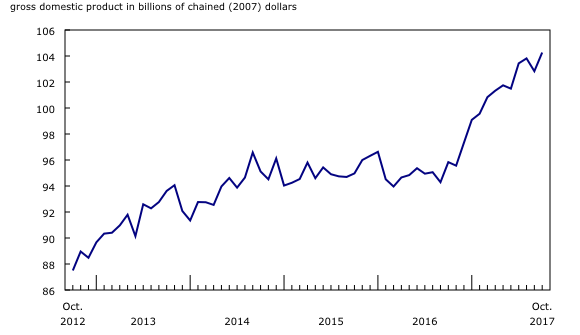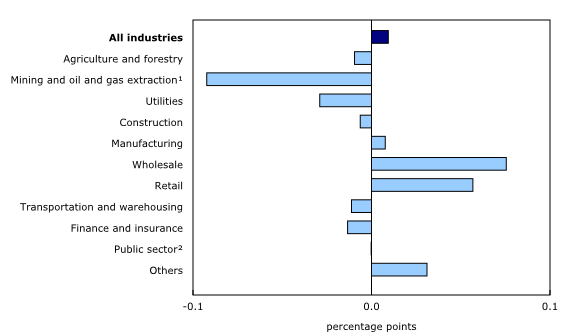Gross domestic product by industry, October 2017
Archived Content
Information identified as archived is provided for reference, research or recordkeeping purposes. It is not subject to the Government of Canada Web Standards and has not been altered or updated since it was archived. Please "contact us" to request a format other than those available.
Released: 2017-12-22
October 2017
0.0% 
(monthly change)
Real gross domestic product (GDP) was essentially unchanged in October following 0.2% growth in September, as 9 of 20 industrial sectors expanded.
Service-producing industries rose 0.2%, mainly from growth in wholesale trade, retail trade and real estate. Meanwhile, goods-producing industries contracted 0.4%, largely due to the mining, quarrying, and oil and gas extraction sector.
Wholesale and retail grow
The wholesale trade sector grew for the 9th time in 11 months in October, with a 1.4% rise more than offsetting September's decline of 0.9%. Six of nine subsectors expanded, led by wholesalers of machinery, equipment and supplies (+3.4%), personal and household goods (+3.2%) and petroleum products (+3.1%). The wholesaling of motor vehicles and parts declined 1.7% as automotive imports decreased.
The retail sector expanded 1.1% in October, almost offsetting three consecutive months of declines. Gains were posted in 7 of 12 subsectors, led by a 2.3% increase at motor vehicle and parts dealers as activity at new and used car dealers was up. General merchandise stores gained 2.4%, more than offsetting three months of declines. Food and beverage stores were up 1.0% while building material and garden equipment and supplies continued to grow, rising 2.0%.
Real estate and rental and leasing up
Real estate and rental and leasing rose 0.3% in October. Activity at the offices of real estate agents and brokers (+2.1%) was up for the third month in a row, led by increased home resale activity in Ontario and British Columbia. However, the level of activity of this subsector remains below its March 2017 level, following provincial government changes to housing regulations in Ontario in April.
Mining, quarrying, and oil and gas extraction declines
Mining, quarrying, and oil and gas extraction was down 1.1% in October, the fourth decline in five months.
Oil and gas extraction declined 0.7%. Non-conventional oil extraction was down 3.5% in October, the fourth decrease in five months, reflecting in part a loss of capacity during maintenance operations. Following a 5.1% gain in September, conventional oil and gas extraction was up 1.8%, led by increased crude petroleum extraction.
Mining excluding oil and gas extraction contracted 0.8% after six consecutive months of growth. Non-metallic mineral mining fell 1.9% as potash mining dropped 5.3%. Other non-metallic mineral mining excluding potash grew 3.6%.
Metal ore mining edged up 0.1% as growth in iron ore (+1.4%) and gold and silver ore (+1.8%) was partly offset by declines in copper, nickel, lead and zinc (-1.3%) and other metal ore mining (-1.8%). Coal mining declined 1.8%.
Support activities for mining, oil and gas extraction declined 5.2%. This was a fourth consecutive decline after a string of increases that began in the spring of 2016 and ended in April 2017.
Finance and insurance continues to decline
Finance and insurance (-0.2%) declined for the fourth month in a row in October. Financial investment services, funds and other financial vehicles (-1.5%) were down for a fourth consecutive month, as market activities declined. Insurance carriers and related activities edged up 0.1%, while depository credit intermediation and monetary authorities were essentially unchanged.
Construction edges down
The construction sector edged down 0.1% in October following four consecutive monthly increases. Repair construction fell 0.3% after rising 1.6% in September. Non-residential construction contracted 0.3%, as a decline in commercial construction more than offset growth in industrial and public construction.
Residential construction (-0.1%) was down slightly as declines in single-family dwellings and home alterations and improvements more than offset growth in doubles, rows and apartment dwelling units. Engineering and other construction activities edged up 0.1%.
Transportation and warehousing declines
Transportation and warehousing was down 0.2% as six of nine subsectors declined. Support activities for transportation contracted 0.8%. Rail transportation decreased 1.1% as rail movement of automotive products, grain and fertilizer, coal and intermodal freight were down. Pipeline transportation was down 0.4% as growth in pipeline transportation of natural gas (+0.7%) was more than offset by a decline in crude oil and other pipeline transportation (-1.5%).
Manufacturing edges up
The manufacturing sector edged up 0.1% as growth in non-durable industries (+0.3%) was partly offset by a decline in durable industries (-0.1%).
Non-durable manufacturing was up in five of eight subsectors. Petroleum and coal products (+3.5%), plastic and rubber products (+1.8%) and beverage and tobacco products manufacturing (+2.4%) contributed the most to the growth. There were declines at paper (-3.7%), printing and related support activities (-4.9%) and chemical products manufacturing (-0.2%).
Durable manufacturing was down slightly as a decline in transportation equipment manufacturing offset growth in 7 of 10 subsectors. For the fourth time in five months, transportation equipment was down (-2.4%), as five of its seven industry groups decreased. Work stoppages and some assembly plant shutdowns in October partly contributed to decreases in the manufacturing of motor vehicles (-5.5%) and motor vehicle parts (-2.5%).
Aerospace and parts manufacturing declined 0.4%, reflecting lower exports of aircrafts and aircraft engines and parts. The largest increases in output were posted by manufacturers of wood products (+3.2%), fabricated metal products (+1.6%) and primary metal (+1.9%).
Other industries
The public sector was unchanged in October following 0.3% growth in September. Educational services were essentially unchanged after growing 0.5% in September. The community colleges and CEGEPs subsector declined 4.6% as a result of a strike by Ontario community college faculty staff that started on October 16. In other components of the public sector, health care and social assistance edged up 0.2% while public administration edged down 0.1%.
Utilities contracted 1.3% as both electric power generation, transmission and distribution (-1.0%) and natural gas distribution (-4.2%) declined. October's decline offset higher activity in September in response to volatile and unseasonal weather conditions.
Accommodation and food services edged up 0.1%. Activity at food services and drinking places was up slightly (+0.1%) while accommodation services edged down 0.1% after six months of growth.
After three months of growth, activity at professional services was essentially unchanged, as there was growth in computer systems and related services and decreases in other subsectors.
Agriculture, forestry, fishing and hunting (-0.6%) was down for the 9th time in 12 months.

In celebration of the country's 150th birthday, Statistics Canada is presenting snapshots from our rich statistical history.
October 2008 marked the beginning of the 2008-2009 global financial crisis. Economic activity in the G-7 countries fell by 2% in the fourth quarter of 2008 and the first quarter of 2009, reflecting sharp declines in global trade volumes.
The Canadian economy contracted for three consecutive quarters beginning with the fourth quarter of 2008, as goods exports and business investment declined notably. Canada's economy experienced sharper contractions than the United States in the first two quarters of 2009.
After edging down 0.1% in October 2008, real GDP in Canada decreased for seven consecutive months, including drops of 1.0% in November 2008 and 1.4% in December 2008, the largest declines in 26 years. Declines were broadbased across industries during the period. There were decreases in 13 of 20 sectors in the fourth quarter of 2008 and the first quarter of 2009 and in 14 of 20 sectors in the second quarter of 2009, with 10 sectors showing losses in all three quarters.
During the fourth quarter of 2008 and the first two quarters of 2009, output declined notably in goods industries, such as manufacturing and mining, quarrying and oil and gas extraction, which reflected lower global trade volumes. However, output also declined for industries such as wholesale trade, utilities, transportation and warehousing and professional, technical and scientific services. Activity for offices of real estate agents and brokers also declined during this period, although to a lesser extent than the declines in real estate activity in the United States.
The economy registered its first post-recession quarterly gain in the third quarter of 2009. Growth was positive in 12 of the 20 sectors, led by the real estate and rental and leasing, construction, wholesale trade, and manufacturing sectors.
Output accelerated in the following two quarters. Mining, quarrying, and oil and gas extraction, manufacturing, and construction led the gains in these quarters. The Canadian economy bounced back to pre-recession levels in the fourth quarter of 2010.
Sustainable Development Goals
On January 1, 2016, the world officially began implementation of the 2030 Agenda for Sustainable Development—the United Nations' transformative plan of action that addresses urgent global challenges over the next 15 years. The plan is based on 17 specific sustainable development goals.
The release on gross domestic product by industry is an example of how Statistics Canada supports the reporting on the Global Goals for Sustainable Development. This release will be used in helping to measure the following goal:

Note to readers
Monthly gross domestic product (GDP) by industry data at basic prices are chained volume estimates with 2007 as the reference year. This means that data for each industry and each aggregate are obtained from a chained volume index, multiplied by the industry's value added in 2007. Monthly data are benchmarked to annually chained Fisher volume indexes of GDP obtained from the constant-price supply and use tables (SUT) up to the latest SUT year (2014).
For the period starting with January 2015, data are derived by chaining a fixed-weight Laspeyres volume index to the prior period. The fixed weights are 2014 industry prices.
This approach makes the monthly GDP by industry data more comparable with expenditure-based GDP data, which are chained quarterly.
All data in this release are seasonally adjusted. For information on seasonal adjustment, see Seasonally adjusted data – Frequently asked questions.
For more information on GDP, see the video What is Gross Domestic Product (GDP)?
Revisions
With this release of monthly GDP by industry, revisions have been made back to January 2017.
Each month, newly available administrative and survey data from various industries in the economy are integrated and result in statistical revisions. Updated and revised administrative data (including taxation statistics), new information provided by respondents to industry surveys, and standard changes to seasonal adjustment calculations are incorporated with each release.
Real-time CANSIM tables
Real-time CANSIM table 379-8031 will be updated on January 15, 2018. For more information, consult the document Real-time CANSIM tables.
Next release
Data on GDP by industry for November 2017 will be released on January 31, 2018.
Products
For more information about monthly national GDP by industry, see the System of Macroeconomic Accounts module on our website.
The User Guide: Canadian System of Macroeconomic Accounts (13-606-G) is also available.
The Methodological Guide: Canadian System of Macroeconomic Accounts (13-607-X) is also available.
Contact information
For more information, contact us (toll-free 1-800-263-1136; 514-283-8300; STATCAN.infostats-infostats.STATCAN@canada.ca).
To enquire about the concepts, methods or data quality of this release, contact Allan Tomas (613-790-6570), Industry Accounts Division.
- Date modified:




